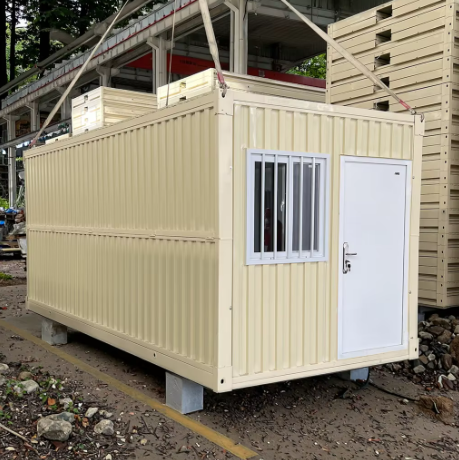The Rise of Modular Houses in Sustainable Living
Why Modular Homes Are Redefining Eco-Friendly Housing
Modular homes are changing what we think about green living through creative design approaches and building techniques that actually work. With people getting more aware of their environmental impact these days, interest in this type of housing has really taken off, showing how sustainability is becoming something serious in real estate circles. A recent study from McKinsey & Company points out that right now modular builds only make up around 4% of all houses in America, but things are moving fast because folks love the green angle. The way these homes are built away from job sites helps cut down on trash and saves money on materials too. Some industry insiders say modular construction produces almost half the carbon emissions compared to regular building methods. All these lower emissions mean modular options stand out as a smart choice for anyone wanting an eco-friendly lifestyle without giving up comfort or good looks.
Key Advantages of Modular Construction for Sustainability
Modular construction brings benefits that go well past just being green friendly stuff. Efficiency and how adaptable these buildings are really matter when talking about sustainability. When builders put up modular structures, they cut down on waste because everything fits so precisely during assembly, meaning there's not much leftover materials lying around. Plus, since modular methods require less timber overall, forests stay intact better than what happens with traditional construction techniques. Another big plus is speed – getting a modular house built takes less time, which means using fewer resources throughout the whole project. A Cambridge study actually found that development sites need about 80 percent fewer truck deliveries when working with modular components. And here's something pretty cool too: these houses can literally be taken apart and moved somewhere else! Homeowners love this flexibility aspect, and it definitely supports living sustainably. Just imagine being able to reuse entire walls or rooms instead of tearing them down completely whenever someone wants to relocate their family.
Energy Efficiency and Innovative Design in Modular Homes
Passive Solar Design and Thermal Performance
Passive solar design plays a big role in making modular homes more energy efficient. When built properly, these homes take advantage of their location and orientation to maximize sunlight exposure, cutting down on both heating bills and the need for electric lights during the day. Research from the National Renewable Energy Laboratory shows that houses with good passive solar design can maintain stable indoor temperatures throughout all seasons. The trick is placing windows where they'll catch morning sun while avoiding overheating later in the afternoon. Thermal mass materials like concrete floors help store heat when it's warm outside and release it back into the house at night. For anyone building or buying a modular home today, incorporating these design elements means getting an environmentally friendly living space that also saves money month after month on utility expenses.
Smart Home Technologies for Net-Zero Energy Living
Smart home tech plays a big role in helping modular homes reach net zero energy status. These homes now come equipped with intelligent systems that handle heating, cooling, and overall energy management pretty well. Take smart thermostats for example they automatically tweak temperatures when people are around or away from home, which cuts down on wasted energy. According to some research from the International Energy Agency, households using these kinds of systems tend to save between 15% and 20% on their energy bills. As technology continues to advance, it's becoming easier than ever before for homeowners to install solar panels alongside battery storage solutions. This combination leads to real money savings on monthly utilities while still maintaining comfort levels inside the home. Plus, going green doesn't mean sacrificing convenience anymore either.
Sustainable Materials and Construction Techniques
Locally Sourced and Recycled Building Materials
Green building really takes off when we start using materials that come from nearby areas or have been recycled somehow. When builders grab stuff right from their own region instead of shipping it across country, they slash those transportation costs and all the carbon pollution that comes with moving things far distances. Take wood grown in the same state or bamboo that's readily available nearby – this cuts way back on what normally would be huge environmental costs tied to regular construction supply chains. And let's not forget about recycled stuff either. Insulation made from old plastic bottles or scrap metal does double duty: it keeps tons of garbage out of landfills while also saving us from having to dig up new raw materials. The EPA actually did some research showing that going green with material sourcing can knock about 15% off total carbon emissions. Makes sense why more and more modular home companies are jumping on this bandwagon these days.
Waste Reduction Through Precision Manufacturing
Getting precise with manufacturing makes a big difference when it comes to cutting down on waste in building modular homes. The process basically means making parts according to very specific measurements inside controlled settings, which results in way less junk lying around than what we see with old school building methods. According to some research from the Building Research Establishment, these kinds of homes actually cut construction waste almost in half because everything fits together so well without needing extra bits here and there. We're also seeing new ways of doing things pop up all the time. Take 3D printing for instance. It lets builders create custom designs without generating much waste at all. All these improvements don't just mean less trash going to landfills. They help make modular housing greener too since fewer materials get used up overall, and our planet definitely benefits from that kind of thinking.
Cost-Effective and Scalable Eco-Friendly Housing Solutions
Affordability of Modular vs. Traditional Construction
More people are starting to look at modular homes as a cheaper option compared to regular houses, especially when money matters. Industry folks generally notice that building costs run somewhere between 10% and 30% less per square foot for modular construction versus traditional methods. That kind of price gap really opens things up for families who might otherwise struggle with conventional housing prices. Plus, there are quite a few financial perks available too. Tax breaks and green energy grants tend to favor modular builds, making them even more wallet friendly. Homes built to certain energy standards usually get access to these programs, cutting down on what needs to be paid out of pocket. Looking at actual projects shows how budgets work better with modular approaches. Many builders report saving money across the board while still getting quality results, which explains why more homeowners are giving modular housing serious thought these days.
Flexible Designs for Urban and Rural Environments
Modular homes come with designs that really work across different places and environments, so they fit just fine whether someone wants to live in a city or out in the country. The cool thing is these homes can actually be tailored to handle whatever nature throws at them locally. Think about it - some areas get heavy snowfall, others deal with strong winds or earthquakes. Modular construction meets all those federal standards for safety against these elements, which means the houses stand up pretty well no matter what climate zone they end up in. We've seen this flexibility play out successfully around the world. Take Stockholm's Hammarby Sjöstad neighborhood as one real world case study where modular units have helped create something truly green and sustainable. The whole project focuses on cutting down on transportation emissions since materials don't need to travel far from manufacturing sites to final destinations. Looking at all these applications shows modular housing isn't just versatile but also makes good sense environmentally when trying to balance modern living needs with our planet's health.
The Future of Eco-Conscious Living with Modular Houses
Trends in Circular Economy and Carbon-Neutral Homes
A shift toward circular economy concepts is changing how people build modular homes today. The focus on reusing resources and cutting down waste means builders now follow different rules when constructing houses. We're seeing all sorts of new stuff happening too – think wood panels that break down naturally over time, insulation made from recycled plastic bottles, and house designs that need far less electricity to run. A recent report from Cambridge and Edinburgh Napier Universities found that building modules instead of traditional stick-built homes cuts carbon emissions during production by around half. For developers looking to cut costs while helping the planet, these changes matter a lot. Homebuyers want their roofs over head to last longer without harming nature either. So companies are finding ways to make sure their buildings stay useful for decades before eventually being taken apart and reused somewhere else entirely.
Policy Support and Global Adoption of Modular Housing
Modular housing is gaining ground worldwide thanks to government support and various international efforts pushing the envelope. Governments everywhere seem to be catching on to how good this approach is for both the environment and wallets, so they're throwing more incentives at modular construction lately. Take Sweden and Japan as prime examples where modular buildings have become pretty common. About 45% of Swedish homes now come from factory settings instead of traditional site building. Public funding programs are making green housing more accessible while giving developers better terms when they work on modular projects. Even big international deals like the Paris Agreement quietly back these building techniques as part of their plans to fight climate change. All these policy supports matter because they help push modular housing beyond niche status into something that could reshape how we build homes across the globe in coming years.
FAQ Section
What is a modular home?
A modular home is a prefabricated house designed and built off-site in sections (modules) before being assembled on-site.
How are modular homes environmentally friendly?
Modular homes are eco-friendly because they use sustainable construction methods that reduce waste and minimize carbon emissions.
Are modular homes more affordable than traditional homes?
Yes, modular homes can be 10% to 30% cheaper per square foot compared to traditional homes, making them more cost-effective.
Can modular homes be customized for different environments?
Absolutely! Modular homes offer flexible designs that can be tailored to meet specific geographical and environmental needs.

